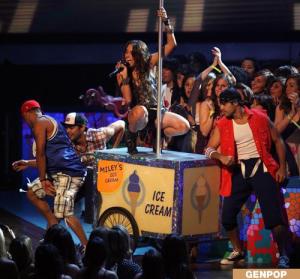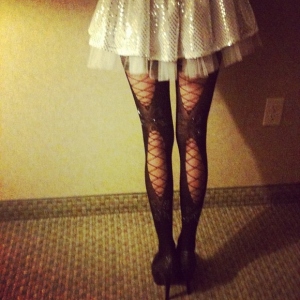
I don’t remember how old I was the first time I went shopping with my grandmother– I think I was about thirteen or fourteen, probably. It was around my birthday, and she decided that we needed to have a day, just the two of us. We went to the mall, and she wanted to buy me something I liked– her treat. I was ecstatic. At this point in my life, I couldn’t remember having something that wasn’t a hand-me-down from girls at church or purchased at a thrift store. To have something new was going to be amazing. And I would be shopping with my grandmother, who to this day is one of the cutest, most fashionable and stylish women I’ve ever known.
We were in one of the department stores, probably Penney’s or Sears, and in the shoe section. I remember staring at a display of juniors shoes– Mudd and the like. There was one shoe in particular–a black leather mary jane pump. And I wanted it. Oh, I wanted it bad.
But then the internal monologue started up. The thousand-and-one reasons why I couldn’t have it– shouldn’t even want it, in fact. The heel is too high– what are you trying to do? Add an inch to your stature? And why care you for raiment? It will make you vain. You’ll attract attention– a boy’s attention. You don’t deserve something that pretty. You’ll make it harder for boys not to stare at you. You’ll make the other girls mad.
My grandmother saw me staring and asked me if that shoe was what I wanted for my birthday.
Yes was trying to burst out of my mouth. I took in a deep breath and did the right thing. “No.”
She knew better than to believe me. “Why not? Don’t you think it’s cute?”
Yes! It’s the cutest shoe I’ve ever seen! It would go so perfectly with my plaid skirt! “It’s too worldly,” I said instead, trying to muster up some self-assurance. I don’t think I’ll ever forget the look on my grandmother’s face– she was surprised, and a teensy bit horrified.
The rest of the day did not go much better. She kept trying to steer me toward cute, age-appropriate clothing, and I kept heading straight for the drab, matronly, sack-like garments. She wanted something bright, colorful, something flattering and stylish. I was becoming a young woman, she said, and my clothes should reflect that. And I was miserable, because I was fighting with myself the entire day. All those gorgeous clothes, the adorable shoes, and I wanted it all. They were pretty— couldn’t I, just once, have something pretty? But no, there was a carousel spinning around my head, a carousel of guilt, shame, fear of being judged, fear of causing a boy to stumble and being an adulteress in my heart, fear, shame, guilt, fear, shame, fear.
We eventually left the mall– with a CD, I think. And I remember being in bed that night and my grandmother sharing her concerns with my parents. Couldn’t she see that I was trying to do the right thing? Why is it so hard?
The single time I ever gave in was when my mom bought me a knee-length aquamarine chiffon skirt and a sky-blue draped blouse with flutter sleeves. I will never forget the look of disappointment on the other girl’s faces, or the look of revulsion and pity on the pastor’s, or the pastor’s son telling me that being able to see my calves had caused him to stumble and fall, or my Sunday school teacher admonishing me to think about what clothes like that could make people think. I wanted to run home, tear my clothes off, and burn them.
I never wore it again.
~~~~~~~~~~~~~~~~~~~~
Nothing changed in the next four years, and, suddenly, I was in college– a college where matronly, sack-like garments were the norm. Not only were they the norm, anything else was against the rules. Pencil skirts, chiffon blouses, empire waists– all of it was suspect and could land you in discipline committee facing a bear-ish woman asking you why you thought it was a good idea to dress like a whore. I remember a few girls– five, rather distinctly– who I judged severely any time I saw them. They were cute– they had co-ordinated outfits, they knew tons of styling tricks for their hair, they wore cowboy boots and chambray shirts, maxi dresses with lace cardigans, and I remember quite viciously loathing them.
I never stopped to think about why my feelings were so intense– I did not know these girls. I only ever spoke to one of them, and I had mentally categorized all of them as a “slut.” They cared about their appearance so much, it was obvious that the only thing they cared about was getting a guy’s attention. If they really had a pure heart, they wouldn’t put so much thought into the clothes they were wearing, or their make-up, or their hair. They were shallow, vain, empty-headed little girls.
Or so I thought. Looking back, they were probably the only brave women in the entire college.
~~~~~~~~~~~~~~~~~~~~~
My senior year, my best friend Rachel* and I had a bad case of senioritis. We escaped off-campus every single chance we could, picking up Sonic and heading for downtown, to a shabby-chic hipster bar with collapsing velveteen furniture and cavernous corduroy sofas in the basement of an abandoned hospital. We went on photography adventures, or we spent entire weekends down by the pier, letting the salt wind play with our hair. Sometimes we would sneak out in the middle of the night to go to the “emergency room” and explore the beach around an old lighthouse. When it was rainy, we hid in Barnes & Noble with chocolate cheesecake and tall mochas. She would get a stack of design rags, and I would pilfer the sci-fi section. We would settle in until the last minute until we had to make a mad dash back to campus before they locked us out.
On a dark and stormy night, there was nothing new in sci-fi, so I picked up one of Rachel’s magazines and flipped through it. It was Vogue, and it was their spring fashion show issue.
I was ensnared.
The moment I touched it, I was that fourteen year old staring a pair of mary jane pumps. I wanted to reverently touch every page, revel in Burberry and Prada and Gucci and McQueen and Betsy Johnson, and I wanted to throw it away from me for the wicked thing I knew it to be. Stop it, Samantha. All this can do is cause you to covet. Why care you for raiment?
I kept looking, loving, adoring, the lovely falls of lace and silk, leather and satin, art and beauty.
You shouldn’t be doing this. It will just hurt, because you’ll never be able to touch any of this. Look at all these poor women, parading their flesh for money. They’re just another kind of prostitute.
And I kept looking, ignoring the stinging sensation of guilt that was turning my stomach into knots. For a few more weeks I kept looking, knowing it was a guilty pleasure. I tried to convince myself, again and again, it was ok just to look. I wouldn’t actually start wearing any of that. Me and my sack-like clothing were just fine.
For a month I tried to tell myself that, and then I saw a crochet-lace floor-length skirt, and I could not help myself.
I bought it, even though it was $80, and I wore it nearly every single time I could possibly justify it, and even times when I knew I couldn’t, and people would judge me because I’d worn it for four days in a row, but I didn’t care. It was beautiful, and it was the first time I had ever felt pretty.
And I learned, slowly, that there is nothing wrong, or sinful, or shameful, about beauty.
There is nothing shameful about dressing my body in a way that I know makes me look attractive. I can buy a top that flatters my shape, and yes– makes my boobs look fantastic. Instead of buying jeans that disguise my rear and are so baggy I appear shapeless, I can buy a pair of jeans because they make my ass look positively bite-worthy. I will buy shorts that show off all the sun my skin has soaked up. I will buy v-neck t-shirts because they look the best on my sloped shoulders, and cleavage be damned. And yes, that t-shirt will have writing across my boobs, and I will not give a flying frack in hell if it stretches or clings. I will buy that knock-out teal lace dress with the wide belt that skims across my thighs. And yes, I will wear a layered chiffon spaghetti-strap tank over a dark wash trouser short to any place or event I damn well feel like.
And no– I will never again ask if an piece of clothing is modest. Clothing cannot even be modest or immodest. Modesty is humility. Modesty is accepting praise with grace and kindness. Modesty is avoiding arrogance and vain deceit.
And no– I will never again ask “would a man stumble if he saw me wearing this?” I REFUSE to mentally participate in a rape culture that removes any blame from the rapist, that assumes a woman’s clothes are her consent. Clothing and what a woman wears is not her “advertising what’s not for sale.”
I love fashion. I love clothes. I love going to a new boutique and running my hands over bouclé and chiffon, picking up jewelry and watching it flash in the light. I love wandering around a shoe store, slipping my feet into scraps of lace and turning my ankle and calf in front of a mirror to admire the sloping curve I’ve worked so hard to have. I love being able to wear a practical, down-to-earth form of art. Art you can touch and wrap yourself in– art you live your life in. That’s what clothes are to me, now– not another tool for oppression and shame, but my personal freedom and ability to express my personality and beauty.










